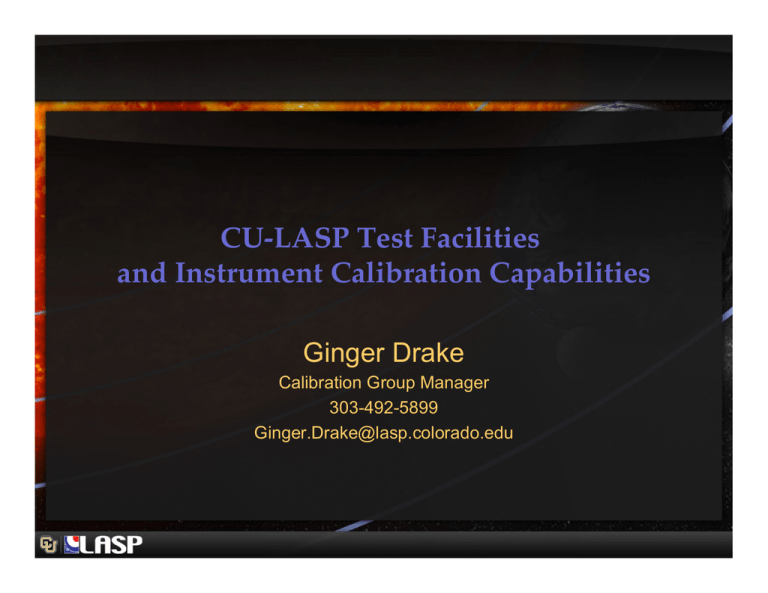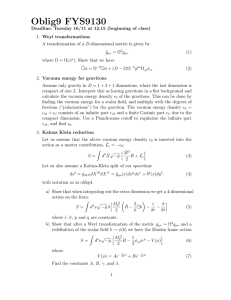CU-LASP Test Facilities ! and Instrument Calibration Capabilities" Ginger Drake Calibration Group Manager
advertisement

CU-LASP Test Facilities ! and Instrument Calibration Capabilities" Ginger Drake Calibration Group Manager 303-492-5899 Ginger.Drake@lasp.colorado.edu 2 Thermal Vacuum Test Facilities" Multiple Optical Beam Instrument (MOBI) • Largest of LASP’s vacuum chambers • Ideal for performing top-level instrument tests – Thermal Vacuum tests – In-band light testing (EUV-IR) • Independently temperaturecontrolled shroud and platen • Optional 4-axis precision gimbal – pitch, yaw, x, y • Interior dimensions: – 60” diameter x 72” length • Temperature range: – -180˚C to +150˚C • Base pressure: – 1 x 10-7 Torr 3 Thermal Vacuum Test Facilities" East and West Bemco™ Chambers • Two similar chambers – One located inside Class-10,000 cleanroom • Platen temperature controlled via recirculating chiller • Optimal for smaller-scale tests – Mechanism performance – Burn-ins – Life tests • Interior dimensions: – 30 Diameter x 48” length • Temperature range: – -75˚C to +80˚C • Base pressure: – 1 x 10-7 Torr 4 Bake Out Facilities" • Three vacuum chambers – Vacuum bake flight & non-flight components – Verify cleanliness and characterize outgassing properties – RGA, TQCM and CQCM • Acceptable materials include: – Metals, PC boards, harnesses, optics, plastics, polymerics, elastomers • – 13 H x 13 W x 16 D to • Air-bake chamber – Room temp to +200C Size ranges 22 H x 21 W x 33 D • Temperature range – +30˚C to +125˚C 5 Optical Vacuum Test Facilities" Calibration and Test Equipment 2 (CTE 2) • Used to calibrate detectors and detector subsystems • Optimized for 120 – 400nm – Computer-controlled monochromator for wavelength selection – Deuterium lamp is primary light source – 2 axis steerable beam • Incorporates NIST-traceable photodetector for absolute measurements • Internal dimensions – 15 H x 23 W x 48 D • Temperature range – -180˚C to +80˚C 6 Optical Vacuum Test Facilities" Calibration and Test Equipment 3 (CTE 3) • Characterization of detectors and detector modules • Optimized for 0.1 – 200nm • Two monochromators – Grazing, normal incidence • Multiple light sources – X-ray: Manson, Fe-55 – EUV: hollow cathode with various process gases • H, He, Ar, N, Ne, etc. – UV: deuterium • Internal dimensions – 24 H x 20 W x 32 L • Temperature range – -180˚C to +80˚C 7 Optical Vacuum Test Facilities" Spectral Radiometer Facility (SRF) • Absolute spectral irradiance & response calibrations • Cryogenic radiometer provides NIST-traceable primary radiometric reference standard • Tunable lasers – 210 – 3300nm – 40mW-18W output power • Five-axis vacuum manipulator • – Pitch, yaw, roll, x, y Internal dimensions – 23 H x 29 W x 40 L • Temperature range – +5˚C to +50˚C 8 Optical Vacuum Test Facilities" Total Solar Irradiance Radiometer Facility (TRF) • Total Solar Irradiance (TSI) instrument calibrations – 0.01% absolute accuracy • 532nm laser light source • Cryogenic radiometer provides NIST-traceable primary radiometric reference standard • Internal dimensions – 24 H x 20 W x 32 L 9 Heliostat Optical Test Facility" Heliostat Lab • 3-mirror system directs sunlight into black optics lab • Equatorial mount in closedloop control – Quad-diode provides real-Sun time tracking – <10 arc-second tracking error • Lab contains class 10,000 clean area with 4 x 8 optical bench for sensitive instruments 10 Environmental Test Chambers" Temperature & Humidity Testing in Atmosphere • 4 programmable test chambers • Dry N2 purge available • Temperature range – -73˚C to +200˚C • Interior dimensions – Range of sizes from 13 x 16 x 17 to 30 x 32 x 36 11 Optical Design & Analysis" • Design and analysis includes: – – – – – – – – – Imagers Spectrographs Hyperspectral imagers X-ray to IR spectrometers Photometers Star tracker Solar position sensors Test & calibration applications End-to-end instrument performance modeling • Stray light analysis • Tolerance & STOP analysis • Industry-standard software – Zemax, FRED 12 3-D Magnetic & Radiation Dose Modeling" • Magnetic designs – Electron rejection magnet arrays – Rejection efficiency models • Radiation shielding and dose models – Analyze 3-D Solidworks models of instruments – High-Z, Low-Z material models – Dose, background signal & noise estimates 13 Instrument Calibration & Characterization" • Optical focus & alignment – In-band temperature-dependent characterization & adjustment of imaging performance • Absolute & Relative Radiometric sensitivity – Absolute to 0.01% through NISTtraceable standards • “Test as you fly” – Characterize instrument performance under thermal & vacuum conditions expected on orbit 14 Custom Detector Design & Fabrication" • Electronic Substitution Radiometer – Solar Spectral detector – >1% absolute accuracy at µW power levels – 100ppm absolute accuracy at total Solar signal levels • Dust Detector • Photomultiplier Tubes (PMTs) • Develop Custom detectors with vendors – Large-format CCDs – Photodiode & diode arrays – Hyperspectral CMOS arrays

